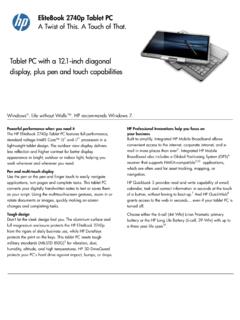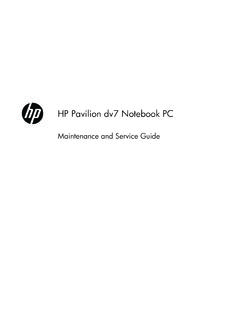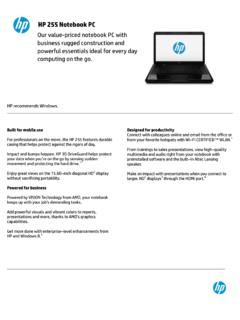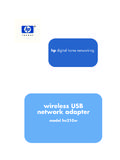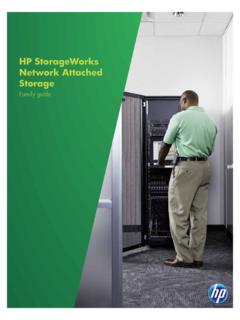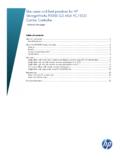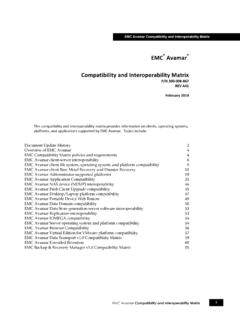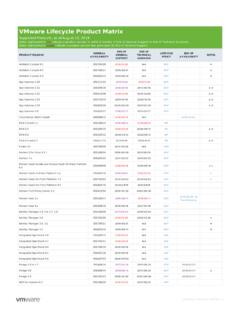Transcription of HP Velocity Overview
1 HP Velocity Overview Copyright 2012 Hewlett-Packard Development Company, and Windows are registered trademarks of Microsoft Corporation. The information contained herein is subject to change without only warranties for HP products and services are set forth in the express warranty statements accompanying such products and services. Nothing herein should be construed as constituting an additional warranty. HP shall not be liable for technical or editorial errors or omissions contained document contains proprietary information that is protected by copyright. No part of this document may be photocopied, reproduced, or translated to another language without the prior written consent of Hewlett-Packard Edition: June 2012 Document Part Number: 689165-001 ContentsTrademarks and patents.
2 2 Disclaimer.. 2HP Velocity Overview4 Benefits of HP Velocity .. 5HP Velocity components.. 6 Operational modes .. 7 Establishing an HP Velocity connection .. 8 Packet loss protection.. 9 Segmentation encoding .. 9 Target loss rate.. 9 Encoding modes.. 9 Summary.. 11HP Velocity Overview4 HP Velocity OverviewHP Velocity is a Quality of Service (QoS) system that improves overall Quality of Experience (QoE) for real-time network applications. Streaming real-time applications over data networks will often suffer from packet loss and transmission latency; this results in stop-and-go behavior, loss of interactivity, and an overall reduction of an application's throughput. Ultimately, application users are likely to find themselves dissatisfied with the Velocity easily integrates with existing systems to improve a streaming application's QoE by addressing the underlying problems found in today's networks: packet loss, transmission latency, and discovery, session establishment, and session management are performed by HP Velocity -enabled endpoints.
3 HP Velocity continuously monitors end-to-end network conditions to select the most appropriate data delivery mechanism. Packet loss is automatically reduced and transmission latency is minimized, thereby improving an application's QoE and : HP Velocity only accelerates streams between HP thin clients and HP Velocity -enabled virtual desktops or terminal services Velocity Overview5 Benefits of HP VelocityAdaptive network analysisHP Velocity continuously monitors end-to-end network conditions for individual data streams, providing adaptive optimizations and data stream loss protectionHP Velocity protects against packet loss, which is key to improving an application's QoE. Even in small amounts, packet loss will reduce application throughput, degrade or halt streaming applications, and introduce lag for interactive detectionHP Velocity automatically detects network congestion and adjusts the amount of redundancy, thus maximizing QoE over data accelerationHP Velocity automatically reduces latency and transmission times for wireless networks and minimizes protocol overhead, resulting in improved QoE for WiFi integrationHP Velocity is a transparent, plug and play solution, which provides QoE benefits to all applications and Velocity is delivered as a lightweight implementation.
4 Which achieves QoE benefits while keeping system resource utilization to a Velocity Overview6HP Velocity componentsThe HP Velocity solution consists of three key components (depicted in Figure 1) which form an integrated system dedicated to improving the overall 1. HP Velocity componentsLink Profiler The Link Profiler profiles the network link between HP Velocity -enabled endpoints. It identifies the type of network connectivity (wired or wireless) and measures key network metrics (packet loss, latency, bandwidth constraints). The Link Profiler continually updates the QoS Controller on current network ControllerThe QoS Controller uses the current and trending network conditions provided by the Link Profiler to intelligently activate and tune the Optimizers. OptimizersHP Velocity supports three types of optimizers that contribute to QoE: 1.
5 Network Optimizers address end-to-end issues such as packet loss. HP Velocity protects application streams from network loss by automatically adapting the amount of added Link Optimizers address access issues such as WiFi congestion. HP Velocity accelerates application streams by leveraging WiFi multimedia standards to minimize latency and prioritizing HP Velocity data Protocol Optimizers address protocol-specific issues with network impairments. HP Velocity optimizes bandwidth utilization by minimizing TCP overhead on half-duplex links (including WiFi).HP Velocity Overview7 Operational modesHP Velocity offers three modes of operation Active mode, Monitor mode, and Disabled modeActive mode is the default and recommended mode of operation. In this mode HP Velocity provides session establishment, session statistics, packet loss protection, and transmission latency optimization.
6 Monitor modeIn Monitor mode HP Velocity is continuously profiling the end-to-end network conditions over established sessions. This mode is useful when acquiring baseline network modeIn Disabled mode HP Velocity passes all network data streams transparently and does not perform any monitoring and Velocity Overview8 Establishing an HP Velocity connectionThe process of forming an HP Velocity -accelerated connection can be described as a set of four steps, as shown in Figure 2. Establishing a connectionInitializationHP Velocity -enabled endpoints start streaming data transparently. During the initialization phase, no optimizations are an HP Velocity -enabled endpoint detects that a bidirectional network path is available, it will periodically modify IP headers (non-destructively) to advertise itself to other HP Velocity -enabled endpoints.
7 This process is called beaconing. Reception of a beacon indicates that a remote HP Velocity -enabled endpoint exists. During the beaconing phase, no optimizations are HP Velocity -enabled endpoint will initiate a three-way handshaking procedure with a discovered HP Velocity -enabled endpoint. Once the three-way handshake is complete, both HP Velocity -enabled endpoints enter into the accelerated stateThe accelerated state allows HP Velocity -enabled endpoints to exchange current and trending network conditions. These are then used to intelligently activate and tune various optimizers. NetworkOriginal application payloadInitializeBeacon added to streamHP Velocity HandshakeOriginal payloadsHP Velocity Segments (Connected)Original payloadsBeaconHandshakeAcceleratedHP Velocity -enabledthin clientHP Velocity -enabled server(virtual desktop or terminalservices server)Beacon added to streamHP Velocity Overview9 Packet loss protectionSegmentation encodingHP Velocity protects against network loss by applying mathematical transformations to IP a single packet as an input, the HP Velocity transformation will output one or more segments.
8 Each segment will logically represent a portion of the input packet and may carry additional information, such as redundancy number of logical segments that are used to represent the original packet will vary based on current network loss conditions. Figure 3 below shows a packet being transformed and sent over the network as three distinct 3. HP Velocity transformation of a packetTarget loss rateStreaming applications may tolerate a small amount of packet loss in a graceful manner. HP Velocity is configurable in terms of how aggressive it is when protecting against packet HP Velocity Target Loss Rate (TLR) parameter allows network administrators to specify the point at which additional protection is no longer required, in terms of the corrected network default and recommended value for the TLR is , which is appropriate for VDI modesThe encoding mode determines the number of logical data segments that are generated based on the original packet.
9 The encoding mode also determines if HP Velocity will create a redundant a session's lifetime, HP Velocity automatically adapts a session's encoding mode according to the configured TLR and to the session's current network relationship between corrected loss and network loss, for a uniform packet distribution and for the given encoding modes, is shown in Figure VelocitytransformationApplicationPacketS egmentsHP Velocity Overview10 Figure 4. Packet loss recovery rates by encoding levelFigure 5 below demonstrates the encoding mode selected by HP Velocity , given a configured TLR of versus network 5. Corrected loss for TLR of Velocity Overview11 SummaryHP Velocity 's patented technology is exclusively available on HP thin clients. It provides a seamless, integrated QoE solution for both managed and unmanaged networks.
10 This enables organizations to gain valuable insight into their thin client data streams, offload more expensive infrastructures (such as MPLS networks) to lower cost networks, and achieve maximum performance regardless of network major benefits HP Velocity provides for HP thin clients are: End-to-end visibility of thin client data streams In-depth monitoring and reporting Packet loss protection WiFi acceleration Support for all VDI protocols including RGS, PCoIP, RDP, and ICAHP Velocity accelerates data streams between HP thin clients and HP Velocity -enabled servers including terminal services and virtual desktops hosted by VMware, Citrix, and Microsoft hypervisors. To obtain the HP Velocity server side components and associated documentation, visit Select the country/region from the map and then select Product Support & Troubleshooting.
